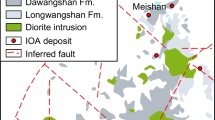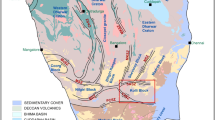Abstract
Iron-rich olivines (Fa100∼Fa70Fo30) experimentally altered in alkaline and acidic aqueous oxidizing environment were examined in transmission electron microscope to determine the precipitate phases and their crystallographic relationships to the host. The planar zones consist of precipitates of laihunite and hematite in alkaline aqueous oxidizing environment while hematite and amorphous silica in acidic aqueous oxidizing environment. The directions of planar zones produced in alkaline aqueous oxidizing environment are parallel to (100)∼(001) of olivine dependent on the composition of the host olivines, while those produced in acidic aqueous oxidizing environment are always parallel to (001) of olivine independent from the composition of the host olivine. These differences are interpreted by the dissolution kinetics of olivine.
The present experimental results explain why the planar zones found in oxidized iron-rich olivines in carbonaceous chondrite are parallel to (100) of olivine while those in terrestrial olivines are parallel to (001) of olivine. That is, the difference is attributed to the pH of the alteration environment.
Similar content being viewed by others
Author information
Authors and Affiliations
Additional information
Received: August 19, 1996 / Revised, accepted: February 14, 1997
Rights and permissions
About this article
Cite this article
Iishi, K., Torigoe, K. & Han, X. Oriented precipitate complexes in iron-rich olivines produced experimentally in aqueous oxidizing environment. Phys Chem Min 25, 8–14 (1997). https://doi.org/10.1007/s002690050080
Issue Date:
DOI: https://doi.org/10.1007/s002690050080




